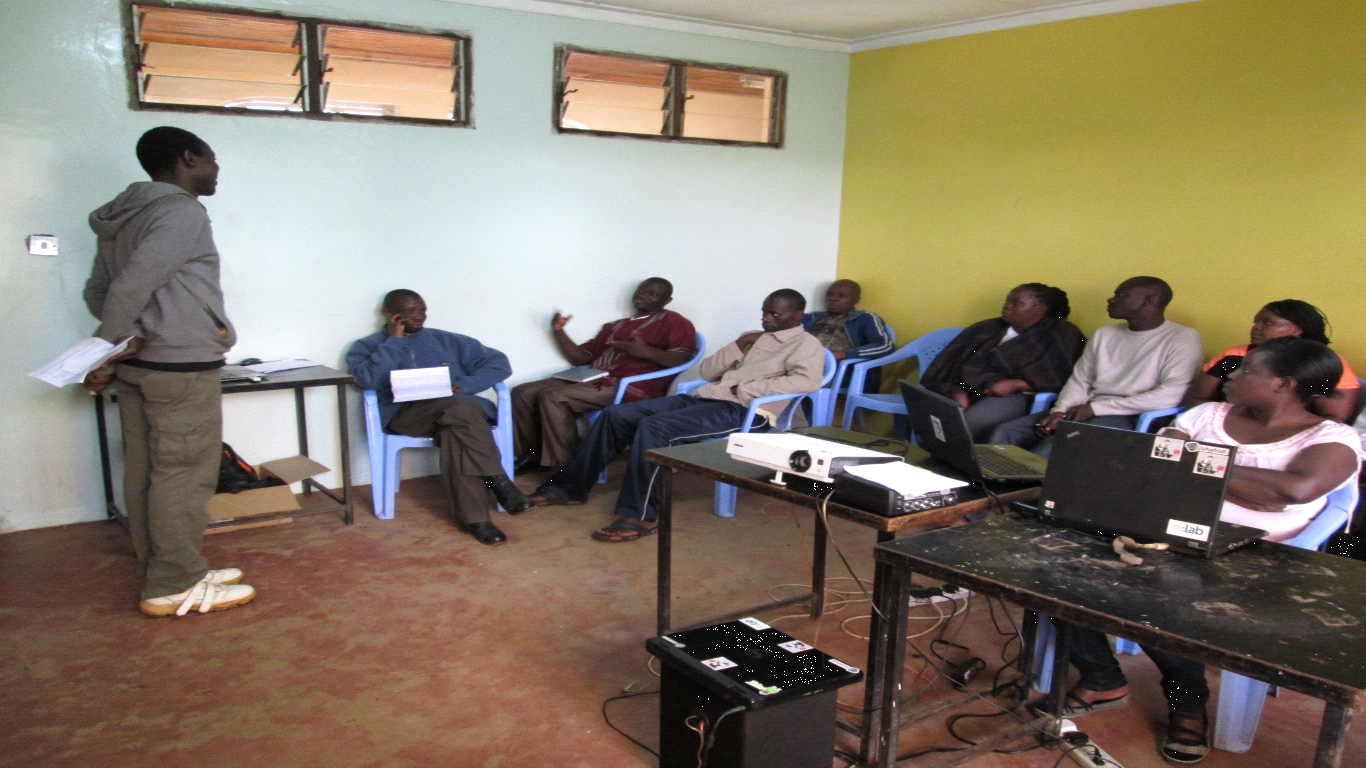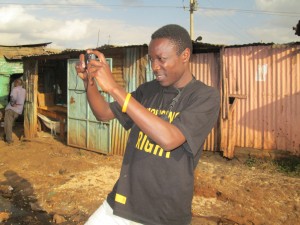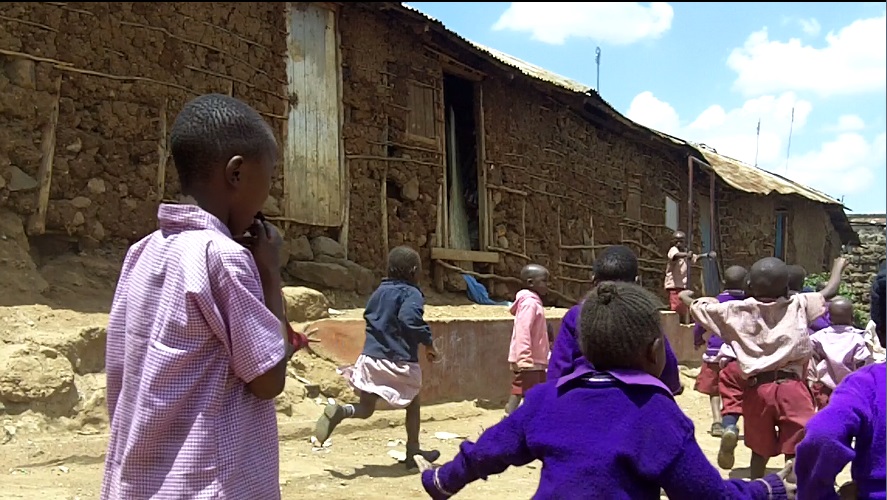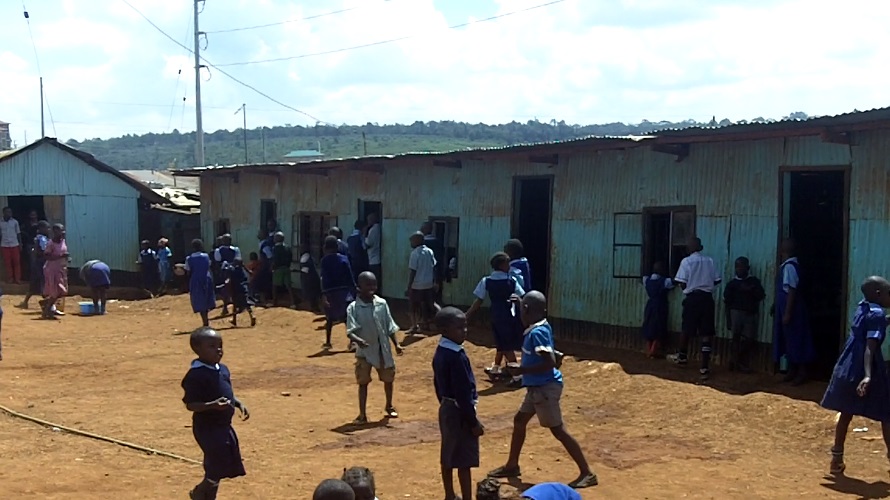by: Joshua Ogure August 14th, 2014 comments:
A Daily Diary post by Map Kibera team leader, Joshua Ogure

Meeting with Parents at AIC Church Olympic
I myself am a parent in Kibera. As a part and parcel of this project, having done the survey as well, I must say this project has already been of great benefit to me. I already know what kinds of schools exist in Kibera, where exactly they are, what programs they offer, and indeed how much they charge, because of this project. In fact I have decided which school my baby class daughter will attend come next year.
But it was interesting to see how other parents responded during a gathering we held to introduce them to our project. On Saturday June 7, 2014, the day after the meeting with teachers, we had a similar meeting with a portion of Kibera parents, held at one of the halls of AIC church in Olympic.
Parents too came late – lateness for parents was considered even more normal than for teachers. Anyway, the first ten minutes saw a very bored, non-interested parent, yeah, there were some technical hitches, one computer refused to connect to the internet keeping a section of parents waiting. Maybe it was the reason for low mood, but as the presentation continued, their presence could be felt. They started asking important questions and the house turned lively.
Different parents have different preferences, and in this meeting parents expressed their interest to have something that could help them make informed choices of which school to take their kids instead of relying mostly on the neighbors, or rumors. Parents wanted information on qualification of teachers, availability of scholarships/sponsors, security of their children, school fees, special programs, e.g. many parents prefer a school with feeding program. Parents also are keen on which faith a school is affiliated to, that is whether Muslim or Christian.
But many Kibera parents do not have an access to the Internet, so how would they get the information? They suggested that the information could be made available to them through printed booklets, SMS, Newsletters, Radio, or printed maps. They also preferred that we find a way to disseminate the data through public “Barazas†and parent meetings at schools.
Parents want all the relevant information including fees published online, something that some teachers were not so comfortable about. Teachers were worried that it would be too easy for the public including “bad people” to just calculate what amount of money a school gets monthly or yearly, if the fee verses the population is put public. They feared that this would trigger attacks at schools since most of the parents pay cash. Parents on the other hand want to know how much schools charge versus how populated they are. Many parents would avoid overpopulated schools.
Parents also were so brave to declare that they will not be worried to have their names attached to a comment on the website for fear of victimization. “In fact that one should be encouraged so that schools can be criticized for a positive change,” says Mr. Nyamweya Ngare, a parent at Olympic Primary School. “It will also increase the level of transparency,” he added.
From these two important forums, the questions, the comments, the points, the concerns and the ideas contributed, helped us get a clear direction on what kind of information to go for. Wednesday the following week we were set to roll, taking pictures and asking questions at every school in the field.
By Joshua Ogure

Joshua Ogure, Map Kibera team coordinator
by: Joshua Ogure May 26th, 2014 comments:
By: Stephene Oduor and Joshua Owino
Map Kibera is now partnering with GroundTruth Initiative, Development Gateway, Feedback Labs, and the Gates Foundation to gather and share information about schools in Kibera.  We will include citizen data and maps, authoritative data, and citizen feedback on education and schools, including the informal sector, making school data transparent and useful to everyone from citizens to NGOs to government.Â
This is the first of a series of blog posts by our Map Kibera resident team that will detail our progress. Map Kibera members have recently been talking to many people – from parents of school children, to school directors – to gather their thoughts about education in Kibera.

Soweto Academy in Soweto West
Education is the key to success in life, so they say. But the information on where the genuine key is offered has proved to be challenge to many parents in Kibera, and some just prefer getting the counterfeit keys than no keys at all, call it informal education.
“We give formal education in an informal setting. If you are going to give informal education to these children, and you expect them to compete with others, I think it’s going to be a very big challenge,†observes Fred Ogutu, School Director at Hope Academy.
The problems that hinder children from Kibera slums from acquiring quality education vary from village to village and school to school, though most of these problems are common in almost all the villages and schools that make up the Kibera slums.
Access to information, or lack of it, is far most the number one challenge that affect both the parents and schools. Most parents, due to various reasons that include poverty, are unable to know which school offers the right key to success and they mostly go for the cheapest school available or as advised by another parent who probably has a child in the same school, or both.
“We live here, we know the challenges that they have, one of them is paying school fees,†says one George Oketch, a teacher at Strays School in Kibera.
Another problem that affects the children, especially those in upper primary and high schools, is engaging in drugs and criminal activities that make them not be able to be in class when required.
A high percentage of private schools, lack enough books and classrooms to accommodate the large number of children who join the schools from the public schools. Whereas in public schools, the missing tool is quality education. Many parents interviewed believe that the teachers in public schools are no longer committed to their work since the introduction of free primary education. This has led to quality of education moving down the scale, hence success becoming more of a dream than a reality in these public schools. But another challenge is that, most of the private schools have not advanced beyond classes four and five, which forces parents to turn to public schools for upper primary education.
Which reminds me, school directors at both Wisdom Ashrays academy and Great Achievers school calls their schools complimentary schools. As a matter of fact, Wisdom Ashrays Director went further to say that there is no private school in Kibera and all schools that are not Public are complimentary schools, which left us a little bit confused. The clarification given to us concerning this was that, complimentary schools are not recognized by the government and the schools are still pushing for them to be recognized. “But I thought all schools that are not public are private schools, because they are owned privately,†I asked myself that. Well, I learnt about complimentary schools for the first time.

Hope Academy in Raila Village
Fred Ogutu, school director at Hope Academy believes that education is part of upgrading the children’s minds to bring positive change in the community.
“You don’t need to physically upgrade Kibera, you can upgrade the children in their minds and then the physical structures will go down,†he says. “In the slum upgrading houses, if you were to walk there now, you will discover that, that place is a slum, the drainage is not working because you don’t upgrade people by doing structures.â€
He also observed that the land in which most of these schools sit is government land, which makes it difficult for donors to help build permanent classrooms because most of the school owners are not sure how long they will be on the land before evictions take place.
“If you have a very temporary thinking about your land tenure system, you cannot invest,†says Fred Ogutu.
Poverty and joblessness has been identified as the biggest problem facing parents in having their children get quality education, as identified by both the parents themselves and teachers. This leads to the children being absent from class most of the time because they either lack school fees or are involved in other income generating activities that prevent them from attending school. This sometimes doubles up with other domestic issues where the parents quarrel hence creating a No-learning atmosphere.
Teachers also pointed out that the Kibera environment does not favour the schools, especially those deep in the slum, because when it rains, it gets so muddy and most children cannot make it to school. Many schools also overflow with a very large number of children in class, this applied to both the private and public schools.
Almost all schools that the survey was carried through offer lunch for the children, at a fee of course, except for the few that have feeding program support such as Mashimoni Squatters School whose feeding program is sponsored by the World Food Program.
Most parents, before taking their children to school, consider Distance, that is how close the schools is from where they live; cost in terms of schools fees; and if the schools offer some food because most of these parents go for work during the day, so they prefer that their children feed at school.
Children are the only raw materials from which you can manufacture responsible human beings, and the concerned parties need to do their best to ensure all children in the slums get good quality education that can help them in the future and shape them to be responsible successful adults.
But until the right and genuine key is given, that is education, success will continue to be a door that is only talked about but never opened.
by: mikel April 24th, 2013 comments:
Map Kibera fields all sorts of data questions from the net and in the community. We’re happy to oblige, our core mission is to openly share and distribute information about the slums, by slum dwellers, for slum dwellers. We also want to share those questions and answers and progress, to show the community of folks who really care about, create, and use this data. This is eventually going to build into thematic sections on a new website, but for the time being, this blog post.
We received two queries from Poverty Action. In context of their other evaluation work in Kenya, they are scoping a study of early childhood education in African slums.
If you have more information on any of these questions, would be great to hear about it in the comments.
What kind of education data is available for Kibera, Mathare and Mukuru?
Mappers have collected basic information on schools in all three slums, available for download in Kibera, Mathare, and Mukuru.
In Kibera, much more detailed data has been collected, on the number of staff, students, status of the facility, programs. That was collected as part of the mapping themes process in 2010, which included meeting with community stakeholders, design of survey, and data collection. Mathare was collected in 2011, and Mukuru in 2012, but in less detail.
The CSV files have the most detail. There are also print maps prepared for Kibera and Mukuru.
Have there been recent census in the slums? Is data available at the household level? Are enumeration area boundaries available?
The last comprehensive census in Kenya was conducted in 2009, and results released in 2010. This made news as the population figures for Kibera differed greatly from the media hype. We wrote about the process and politics of the census back then.
As far as we’re aware, there’s been no public census since then. There have definitely been data gathering exercises, surveys, by all kinds of actors, but unfortunately much of this data remains silo’d and unopened.
Data from the 2009 census is available at OpenDataKE, but only released aggregated to ward or constituency level. Those boundaries were not released, and were changed by the IEBC prior to last month’s election. I’ve never seen Enumberation Area boundaries released, and am not certain they are digitized. There are a few reports out there on the process, which give some explanation of the methodologies, on the Kenya National Bureau of Statistics website and in a UN Data report.



